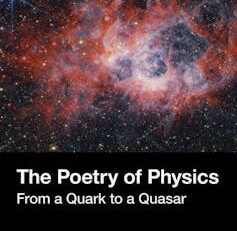
How to write your own physics poem
Physics and poetry might seem like an unlikely pair, but both are rooted in structure, rhythm and precision. Both rely on clarity – distilling complex ideas into their simplest, most elegant form. And, as I explore in my latest book The Poetry of Physics, both seek to capture something fundamental about the universe.
Some physicists have embraced this connection. James Clerk Maxwell, the Scottish physicist and mathematician behind the classical theory of electromagnetic radiation, wrote verse about atoms, thermodynamics and imposter syndrome. Rebecca Elson, an astrophysicist studying dark matter, wrote poems that fused cosmic exploration with human fragility. Their work reminds us that physics is not just about numbers – it is about patterns, motion and meaning.
Writing poetry about science can seem daunting. But structure helps. Just as scientific experiments follow a method, poetic forms can provide a scaffold that can shape your ideas and guide your writing, giving you boundaries within which to explore.
Form matters. The structure of a poem can mirror the scientific idea it describes, making both the form and the content work together. A nonnet, for example, is a perfect choice for writing about loss, decay, or transformation.
A nonnet is a nine-line poem that starts with a line of nine syllables and decreases by one syllable per line, ending with a single-syllable word. This structure creates a natural sense of diminishing, making it ideal for exploring physical processes like entropy, energy loss, or the melting of sea ice. The shrinking lines do not just tell the story – they embody it, visually and rhythmically reinforcing the concept.
Take entropy for example. Entropy is a measure of disorder or randomness within a system. A system with high entropy is more chaotic, while a system with low entropy is more structured. According to the second law of thermodynamics, the total entropy of an isolated system can only increase or remain constant – it never decreases. This natural progression toward disorder can be creatively captured through a nonnet, a poetic form that mirrors the gradual decline of structure.
The tea cools, spreading its warmth outward
Molecules slow, drift apart, fade
Heat unwinds in quiet waves
Order gives way to chance
Each moment less still
Motion dissolves
Atoms hum
Time flows
Gone
The structure mirrors the process it describes – just as the syllables fall away, so too does energy, dissipating into the surroundings. The poem does not just explain entropy; it makes you feel it.
Writing your own physics poem
To start, choose a scientific concept with a natural progression – something that grows, collapses, fades or transforms. A black hole swallowing light. The cooling of a neutron star. The flickering of a quantum state.
Once you have your subject, let the structure guide you. The longest line should introduce the concept, setting up the movement that follows. Each line should shrink not just in syllables but in intensity, following the physical process you are describing. Keep the language clear and simple – both physics and poetry thrive on precision.
Sam Illingworth’s new book brings together art and science.
CRC Press
Most importantly, let the poem take its time. Writing is like experimentation – your first attempt is rarely your final result. Refine, adjust and revise until the form and meaning align.
Once you have experimented with a nonnet, you may want to explore other poetic forms. Different structures can emphasise different aspects of physics, shaping the way the subject is presented and experienced. Perhaps a haiku, a villanelle, or maybe even a sestina?
Eventually, as in physics, structure should not confine you. It should empower you. Just as quantum mechanics could only emerge after centuries of classical physics, free verse poetry becomes most effective once you understand the forms it is breaking away from. Poetic structure teaches control, rhythm and precision. It helps you learn how to balance content and form, just as classical mechanics teaches foundational principles that underpin later discoveries.
Once you are comfortable with structured poetry, try letting go. Write about physics with no predetermined form. Let the language shape itself. See where the words take you.
And when you have something you are happy with, why not share it? The Brilliant Poetry Competition 2025 invites writers from around the world to explore the connections between science and poetry. This year’s competition is themed around UNESCO’s international year of quantum science and technology, with prizes of up to £1,000 and entries accepted in English, French and Spanish.
Physics is already rich with poetry. Its rhythms are found in the orbits of planets, its symmetry is woven into the fabric of the universe, its surprises are hidden in the flicker of quantum states. Writing a physics poem is not about forcing science into art but about recognising the poetry that is already there. The universe is waiting. Now, all you need to do is write. Läs mer…

